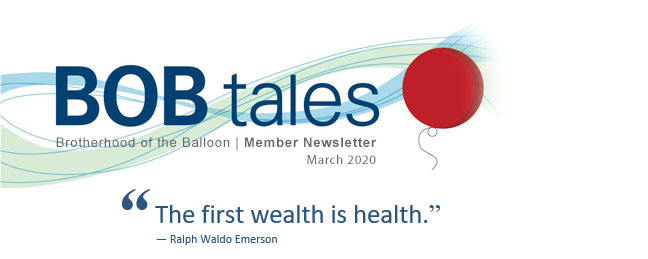
Dear Members (a note from Deb Hickey):
Ten years ago, when I first started working alongside my father, Bob Marckini, I remember asking him, “How do you find all the information for the newsletter? Do you ever have nothing to write about?” I remember him telling me it was quite the opposite – it was a challenge to keep the newsletter fewer than 20 pages.
As I’ve taken over most of the data gathering for the BOB Tales these days, I fully understand what he was talking about. The flow of information about prostate cancer and general health and wellness never seems to subside. I’m inundated with emails and “Google Alerts”; I find myself constantly weeding through information to identify topics I think will be truly valuable to our readers, and I keep a spreadsheet of ideas and links.
So, as always, this newsletter is packed with information including reports on several new studies: a U.K. study that found a major link between physical activity and prostate cancer; a study on saturated fat intake and its link to prostate cancer progression; and a study showing that men who undergo surgery have persistently worse side effects than those who choose other treatments.
This month we also recap our trip to Amelia Island, FL where Bob and I attended the 2020 COMPPARE Workshop. We give more specifics on the release of the second edition of Bob Marckini’s book, You Can Beat Prostate Cancer: And You Don’t Need Surgery To Do It. And we thank our members for another significant rise in year-end contributions to the Robert J. Marckini Endowed Chair for Proton Research at Loma Linda University Health.
It’s also important to mention that the Center for Medicare and Medicaid Services (CMS), that proposed a new regulation that would drastically limit cancer patients’ access to proton therapy, has still not released its final plan. Therefore, there’s still time to submit your comments/stories to your representatives in Congress if you haven’t already. And if you have already contacted your Congressional representative, why not ask five friends to support you by submitting their own letters? Access the “Voter Voice” form on APTA’s website to send an email, post a tweet, and/or make a call.
The CMS proposed change, if implemented, will be severely detrimental to the future of proton therapy (and other advances in cancer treatment), so please act today. Questions on the CMS proposed rule? Send an email to [email protected].
Finally, I thought to share a family photo that was taken over the holidays.
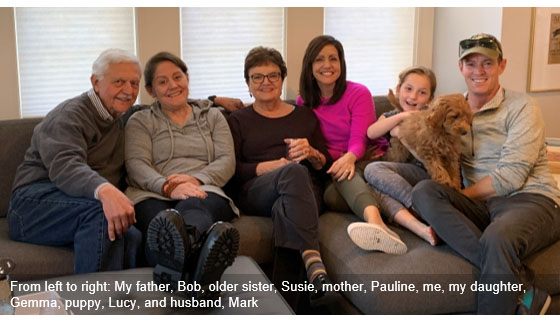
We hope you enjoy this month’s BOB Tales and, as always, we welcome your feedback.
Deb Hickey
To print the BOB Tales newsletter or view the newsletter with a larger font size, click here for the PDF file.
In this Issue:
- Major Link Between Physical Activity and Prostate Cancer
- Saturated Fat Intake Fuels Prostate Cancer Progression
- Prostate Cancer Surgery Patients Suffer Worst Adverse Effects
- Recap: The COMPPARE 2020 Workshop

Major Link Between Physical Activity and Prostate Cancer
Merv Griffin was an American television host and media mogul. He hosted his own talk show, The Merv Griffin Show, and also created the internationally popular game shows, Jeopardy! and Wheel of Fortune, through his television production companies, Merv Griffin Enterprises and Merv Griffin Entertainment.
Merv was quoted in 2007 as saying, “I’ve been very fortunate with my health. I smoke; I drink – not heavily, but I like my wine; I don’t exercise; I take a cab to a cab.” Later that year, he died from a recurrence of prostate cancer that was first diagnosed in 1996.
Could Merv have avoided prostate cancer in the first place (or prevented a recurrence)? Quite possibly. A study from the U.K. uncovered an interesting link between low levels of physical activity and an increased risk of prostate cancer. Researchers gathered medical information from 140,000 men, about 80,000 of whom had prostate cancer. They found that men age 50 and older who exercised regularly reduced their risk of prostate cancer by a whopping 51 percent compared with those who were inactive.
The most interesting thing about this study is that researchers didn’t rely on self-reporting for their findings. They used a method called the Mendelian randomization to study variations in DNA sequencing to discover causal relationships between potential risk factors and the development of prostate cancer. The data revealed that men with a genetic variation that increases their likelihood of being physically active had a lower risk of developing prostate cancer.
It’s important to note that the study refers to physical activity in all of its forms. Even daily walking and gardening are considered exercise. And it’s likely that men would see even better results by running, swimming, bicycling, or other more vigorous activities.
Saturated Fat Intake Fuels Prostate Cancer Progression
According to a new study, saturated fat intake causes a cellular reprogramming that is associated with prostate cancer progression and lethality. Researchers suggest that reducing saturated fat consumption in men with early-stage prostate cancer could potentially diminish or delay the risk of disease progression.
MYC is a gene that contributes to the formation of many cancers. Remarkably, patients who had the highest level of the saturated fat intake “MYC signature” were four times more likely to die from prostate cancer, compared to patients with the lowest level.
Since fat consumption can be linked to an increase in body fat and obesity, and since obesity is also a risk factor associated with prostate cancer, researchers used body mass index (BMI) to make sure that it was only saturated fat intake, not obesity, that promoted the progression to a metastatic and lethal disease.
Even when discounting obesity, patients with high levels of the MYC signature are still three times more likely to die of prostate cancer, according to the study.
Prostate Cancer Surgery Patients Suffer Worst Adverse Effects
 Men undergoing radical prostatectomy for localized prostate cancer had persistently worse side effects from treatment compared to those managed with active surveillance, brachytherapy or external beam radiation therapy (EBRT), a recent study found.
Men undergoing radical prostatectomy for localized prostate cancer had persistently worse side effects from treatment compared to those managed with active surveillance, brachytherapy or external beam radiation therapy (EBRT), a recent study found.
In this prospective cohort study of 1,386 men with low-risk prostate cancer and 617 men with high-risk prostate cancer, few functional differences were seen at five years between the three treatment options. However, sexual function and urinary incontinence were worse for the group treated with prostatectomy compared to those on either active surveillance or external beam radiation therapy plus androgen deprivation therapy (ADT).
We can surmise that if conventional EBRT is better than surgery by all measures, then proton therapy would be even better because the radiation can be concentrated to the target area with less exposure to healthy tissues.

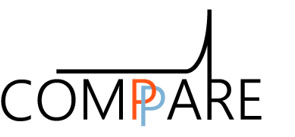 Recap: The COMPPARE 2020 Workshop
Recap: The COMPPARE 2020 Workshop
As you know from previous BOB Tales, this critically important clinical trial is a study funded by the Patient-Centered Outcomes Research Institute (PCORI) and led by Dr. Nancy Mendenhall, Director of the University of Florida Health Proton Therapy Institute.
The intent of the trial is to compare, head to head, proton therapy vs. IMRT to determine the impact of each on cure rates as well as quality of life after treatment, including urinary, rectal, and sexual function side effects. The trial is also intended to determine if the shorter treatment protocol – hypofractionation – is as effective as the longer, standard treatment protocol.
In total, 3,000 patients are being enrolled in this study, half for the IMRT arm and half for the proton arm. Current age eligibility is 30 to 80. Participants will include low-, intermediate- and high-risk localized prostate cancer diagnoses. Those with low risk or metastatic disease or prior radiation to the pelvic region will be excluded from the study.
Additionally, there will be analysis of heterogeneous treatment effects including a comparison by race (black vs. white), age (65 and under vs. over 65), and prostate cancer aggressiveness for all endpoints. Participants are being asked to complete pretreatment surveys and will respond to periodic surveys after treatment ends.
The official start date for the study was July 5, 2018 and was expected to run about five years. Site activation took longer than expected due to some administrative issues and patient registrations are somewhat behind schedule.
Some in the proton arm will be given the opportunity to be randomized into the hypofractionation protocol. All patients will receive the standard of care for whichever treatment they receive. Forty-five treatment sites (proton and IMRT combined) are participating in this important study.
Last month, Bob Marckini, a member of the COMPPARE executive board, and Deb Hickey, who serves on the caregivers-stakeholders group, along with other stakeholders and COMPPARE researchers, attended the COMPPARE 2020 Workshop in Amelia Island, FL. The goal of the event was for attendees to understand the value of the trial for filling the evidence gap in knowledge about the best radiation treatment for prostate cancer; assess the patient eligibility requirements for participating in the trial; attain proficiency in the use of VisionTree, the web-based data-accrual system; learn the underlying ethical and regulatory requirements governing human subject research, and understand best practices in advocacy for the study.
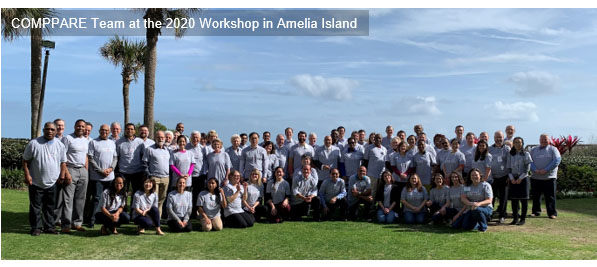
The team is committed to a successful outcome and is working diligently to achieve all our goals.
Learn more about COMPPARE: Visit the COMPPARE website; email a COMPPARE team member at [email protected], or talk with doctors at your proton treatment center.
NAPT 2020: The National Proton Conference
The eighth annual National Proton Conference will be held in Nashville, TN, April 26-29, 2020, at the Renaissance Hotel. Some topics planned for this year’s event include managing health insurance denials and appeals, flash proton therapy, carbon ion particle therapy, the importance of the proton patient experience, updates in clinical research, and the future of proton therapy.
Deb Hickey plans to attend the conference again this year and will provide a detailed recap in the BOB Tales.
If you’re interested in attending or learning more about NAPT 2020, email Jamie Miller.


Protons in the Family
BOB member Drexel Hendon came into this world a miracle. Little did he know that he’d be lucky enough to experience another miracle some 70 years later.
Shortly before the birth of baby Drexel, a midwife assisted in his delivery as a precaution. Drexel’s mother, Bertha, had delivered three premature daughters before her pregnancy with Drexel. None of them survived. Fortunately for Clemon and Bertha Hendon in the 1930s, Drexel made it.
In his early twenties, Drexel entered the U.S. Air Force during the Korean Conflict and served four years. After the service he went to work for the U.S. Postal Service, attended college on the GI Bill, and lived three years on the University of Memphis Campus in “Vet’s Village.”
Drexel was soon married to his wife, Betty. They had a son, Barry. Later, both Drexel and Betty went on to earn their masters degrees.
In 1961, the Memphis Veterans Administration Hospital hired Drexel as an educational-vocational specialist and completed his career in hospital rehabilitation administration. He was elected president of the American Association for Rehabilitation Therapy; served as registrar for the American Association of Rehabilitation Therapists and Specialists; received numerous awards; and served on the Tennessee Easter Seals Board.
In 2005 at age 73, Drexel and his urologist noticed an upward trending PSA. A biopsy was ordered. Drexel recalls going to his urologist’s office with Betty for the biopsy report. When the doctor entered the room, he announced, “Drexel, you have prostate cancer. You should plan to drop by the clinic every 10 days for the next month and have a pint of blood drawn in preparation for a radical prostatectomy.”
Bewildered and fearful, Drexel didn’t hear another word that day. He returned home feeling defeated. After a few tough days, he picked himself up and shared the diagnosis with his son Barry, a veterinarian in Florida. At the time, Drexel was leaning toward brachytherapy.
Two weeks later, Drexel received an unexpected call from Barry. He’d found another treatment option for prostate cancer that seemed promising – proton beam radiation therapy. Barry’s neighbor told him that her father-in-law had been successfully treated with proton therapy in Loma Linda, CA. Intrigued, Drexel began looking into the treatment.
After learning more about the benefits of proton therapy and speaking with the folks at Loma Linda University Cancer Center, Drexel’s decision was made. By the time he started treatment, his PSA had risen to 9.23.
 Drexel and Betty stayed at an apartment complex near LLUCC while he underwent treatment. Drexel described this time in his life as an “extended vacation.” In addition to visiting the Nixon and Reagan Libraries, walking around Palm Springs, hiking in the mountains, and taking advantage of the local shopping malls, the couple attended potluck dinners hosted each Tuesday night at the apartment complex and never missed a Wednesday night meeting.
Drexel and Betty stayed at an apartment complex near LLUCC while he underwent treatment. Drexel described this time in his life as an “extended vacation.” In addition to visiting the Nixon and Reagan Libraries, walking around Palm Springs, hiking in the mountains, and taking advantage of the local shopping malls, the couple attended potluck dinners hosted each Tuesday night at the apartment complex and never missed a Wednesday night meeting.
Drexel feels proton treatment gave him a new lease on life. He’s been cancer free for nearly 15 years. At 88, he says he’s enjoying “reasonably good health for a man my age.” His many hobbies include traveling (Mt. Rushmore, Yosemite National Park, Great Smoky Mountains), walking and working out at his local athletic club (daily!), studying genealogy, reading, and attending Civil War historical seminars, conferences and tours. Drexel and Betty also attend church every Sunday and take part in local senior citizen activities. They also enjoy spending time with family.
Not only is Drexel thankful to proton therapy and Loma Linda for saving and preserving the quality of his life, he’s also thankful for his sister, Wanda Kirkman. Wanda was successfully treated with proton therapy for stage 4 breast cancer five years after Drexel was treated. A busy hostess for a local TV station in Adamsville, TN, a grandmother to several grandchildren and Sunday school teacher, Wanda wasn’t ready to slow down then and she’s still going strong today. “She keeps the road hot,” said Drexel. “She’s well known all over the area and she talks to everyone about proton therapy.”
Drexel also wanted to recognize two people who he says “deserve highest acclaim” for what he refers to as his “miracle” – the late Dr. James M. Slater, “a true visionary;” and Bob Marckini, to whom he’s thankful for founding the Brotherhood of the Balloon.
Drexel recently said to Deb Hickey, “I think it was a stroke of genius for your father to hire you.” Bob agrees.

We’ve been producing BOB Tales newsletters for nearly 20 years. During this time there have been important articles that many new members haven’t seen, and some older members may have forgotten. So, we decided to periodically re-run some articles from past newsletters. In September 2005, BOB member Dr. Terry Wepsic sent us a link to an article on WebMD. Though the link is no longer active, an abstract of the article is below.
Diet and Exercise May Slow Early Stage Prostate Cancer
 A new study shows that diet may play a significant role in stopping, or even reversing, early prostate cancer. Exercising more frequently, even in moderation, may also go a long way in retarding the disease. The study findings apply only to men with early stage prostate cancer.
A new study shows that diet may play a significant role in stopping, or even reversing, early prostate cancer. Exercising more frequently, even in moderation, may also go a long way in retarding the disease. The study findings apply only to men with early stage prostate cancer.
Researchers studied 93 men whose biopsies showed they had early stage prostate cancer. They were divided into two groups. One group consumed a vegan diet of predominantly fruits, vegetables, whole grains, legumes, and soy products. This group was also given the daily supplements soy, fish oil, vitamin E, selenium, vitamin C, and a soy protein powdered beverage. The first group also began a program of moderate aerobic exercise, stress management techniques, and participation in a support group. The second group followed their regular diet and lifestyle regimen as prescribed by their physicians. After a year in the program, PSA levels decreased by an average 4 percent in the first group and increased by an average 10 percent in the second group.
Dean Ornish, MD, clinical professor at the University of California, San Francisco, concurs with the findings, saying, “Changes in diet and lifestyle that we found in earlier research could reverse the progression of coronary heart disease may also affect the progression of prostate cancer.”
While these conclusions are based on men with early stage prostate cancer, you can’t help but wonder if the same diet and lifestyle changes could help slow the progression of moderate- and late-stage prostate cancer as well.
It’s important to note that you shouldn’t rely on lifestyle changes alone to treat prostate cancer without first talking with your doctor. But it appears these lifestyle changes may be factors in slowing or reversing the disease.

Even a Little Alcohol May Elevate Cancer Risk
Japanese researchers compared the drinking habits of 63,232 cancer patients in Japan with those of an equal number of healthy controls. The study, published in the journal Cancer, suggested that even in light-to-moderate levels, alcohol consumption appears to be associated with elevated cancer risks.
Although the impact of lifetime alcohol consumption varied across each cancer site, the elevated overall cancer risk appeared to be explained by alcohol-related cancer risk across relatively common sites, including the colorectum, stomach, breast, prostate, and esophagus.
It’s important to note that study participants self-reported their average daily alcohol intake and the number of years they’d been drinking, which can be unreliable. Researchers were also unable to garner information on family history of cancer, diet, or physical activity level. Furthermore, the Japanese have a higher prevalence of genetic variations that make them slower at metabolizing alcohol, and the results may not be generalizable to other populations.
“One drink a day is probably not a big problem,” said the study’s lead author, Dr. Masayoshi Zaitsu. “But drinking too much over long periods of time might be dangerous …”
Tips for Preventing Coronavirus
The following article is from Loma Linda Health’s news website. Though there’s no vaccine to prevent 2019-nCoV infection, known as the Coronavirus, the following tips will help to avoid being exposed to this dangerous virus. As a reminder, the CDC always recommends everyday preventive actions to help prevent the spread of respiratory viruses.
- Wash your hands often with soap and water for at least 20 seconds. If soap and water are not available, use an alcohol-based hand sanitizer.
- Avoid touching your eyes, nose, and mouth with unwashed hands.
- Avoid close contact with people who are sick.
- Stay home when you are sick.
- Cover your cough or sneeze with a tissue; then throw the tissue in the trash. If you don’t have a tissue, cough or sneeze into your upper sleeve or elbow, not your hands.
- Clean and disinfect frequently touched objects and surfaces.
General respiratory illness is on the rise. This is the time of year that respiratory illnesses are prevalent. Remaining vigilant in following healthy habits is always a good idea.
Learn more from the World Health Organization.

Thank you, Members …
The BOB mission is three-fold:
- To support each other before, during, and after treatment;
- To promote proton therapy worldwide, and;
- To give something back, with emphasis on supporting proton therapy research.
You—our members—have responded generously in all three categories. Many of you have done one, some, or all of the following.
- Volunteered to be listed on our former proton patient reference lists to share your story and communicate with newly diagnosed men;
- Written testimonials about your diagnosis, treatment, and life after treatment;
- Offered information and/or volunteered to be featured in our newsletter and/or our social media outlets;
- Used our PowerPoint presentation to educate family members, friends, and acquaintances about the benefits of proton therapy for prostate cancer;
- Set up support groups in your communities;
- Forwarded our newsletter to family and friends;
- Given copies of Bob’s book to those at risk or those recently diagnosed with prostate cancer and/or donated it to your local doctor’s office or library;
- Found and continue to find every opportunity to have conversations about proton therapy with friends and even strangers.
Many of you have also responded to our repeated requests to “give back” over the past 20 years. Every month we see a list of members who’ve made contributions – from those recently treated and those treated 10, 15 and even 20-plus years ago. In December 2019, 73 members made gifts that ranged from a few dollars to several thousand. We are grateful. Every gift sends us a message that you’re listening to us, and that you care about the future of proton therapy and the many lives that will be spared and the quality of lives that will be maintained—men, women, and most important, children. Thank you.
Give to Proton Therapy Research
- Donate online.
- Write a check to LLUCC Proton (Put “Marckini Chair” on the memo line) and mail it to LLUH, Office of Philanthropy, P.O. Box 2000, Loma Linda, CA 92354.
- Call Regina Joseph at 909-558-5010.
Give to Vision 2020
- Donate online.
- Write a check to LLUH Vision 2020 and mail it to LLUH, Office of Philanthropy, P.O. Box 2000, Loma Linda, CA 92354.
- Call 909-651-2020.

A March Amazon Release!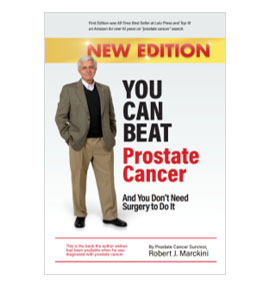
We’ve heard from dozens of members who are wondering when Bob’s new book will be available. We printed proof copies last month and have made final changes. We’ve submitted the final draft for printing and hope to upload the book to Amazon in early March.
Please note: Both versions of the book will be on Amazon for a while. If we remove the original book, we lose more than 400 reader reviews, which average 4.8 out of 5 stars. Amazon doesn’t permit retaining reader reviews for new editions. So, if you’re shopping for the book on Amazon, be sure to look for the gold banner at the top that reads, “New Edition.”
BREAKING NEWS! Although not yet available on Amazon, the new edition can be purchased from Lulu Press at www.lulu.com. In the search box, type the title or “Marckini.” Both old and new editions are there. Be sure to select the book with the gold banner on top.
Note: The printer/publisher has raised prices on us three times since we first published the book. Also, the new edition is 130 pages longer than the first, so there is a retail price increase to cover the additional costs.
As we have in the past, we will discount books in quantity (20 or more). Just send an email to [email protected]. Proceeds from book sales are used to help fund our efforts and to support proton therapy research.
Please write a review on Amazon.

Useless Facts
- There are only four words in the English language that end in “dous:” tremendous, horrendous, stupendous, and hazardous.
- An ostrich’s eye is bigger than its brain.
- In most advertisements, including newspapers, the time displayed on a watch is 10:10.
- Al Capone’s business card said he was a used furniture dealer.
- Humans are born with 350 bones in their body, but when reaching adulthood, we have only 260.
- The characters Bert and Ernie on Sesame Street were named after Bert the cop and Ernie the taxi driver in Frank Capra’s “It’s A Wonderful Life.”
- A dragonfly has a lifespan of 24 hours.
- The average person falls asleep in seven minutes.
- Flamingos can eat only with their heads upside down.
- Only 8 percent of the world’s money exists in physical form, the rest is in computers.

Last Month’s Brain Teaser
This should be easy … but maybe not.
What’s the largest single component of U.S. landfills?
Answer: Discarded food is the largest constituent of municipal solid waste landfills. Plastics rank second. Fruits and vegetables are the main type of food waste, which isn’t surprising. They seldom seem to last as long as you wish. (Source: Parade Magazine Oct. 6, 2019)
Winner: We were inundated with brain teaser answers last month. Interestingly, about half the group answered correctly while the other half answered, “dirt.” Smart!
We’ve sent an email to the winner and are still awaiting his response.
New Brain Teaser
Break the Code (from the Saturday Evening Post): The statement below has been encoded using a simple substitution cipher. Each letter has been replaced with a different one, and the substitutions remain constant throughout. Can you decode it? Hint TEV is WAS
TCDG P TEV KZRTPGK IF, P EATEOV TEGLDS LR MD VRNDRGD. GRT P ZDEAPXD P VCRIAS CEHD MDDG NRZD VFDBPQPB
Bob says this one took him about 15 minutes to solve. Can you beat Bob’s time?
Send your answer to [email protected] for a chance to win a signed copy of Bob Marckini’s NEW second edition book, You Can Beat Prostate Cancer.
Finagle’s Laws of Inverse Negative Dynamics
This was sent to us by BOB member of 13 years, Dick Manning of Reno, NV.
Law of Mechanical Repair: After your hands become coated with grease, your nose will begin to itch and you’ll have to use the bathroom.
Law of Gravity: Any tool, nut, bolt, screw, when dropped, will roll to the least accessible place in the universe.
Law of Probability: The probability of being watched is directly proportional to the stupidity of your act.
Variation Law: If you change lines (or traffic lanes), the one you were in will always move faster than the one you moved to.
Law of the Result: When you try to prove to someone that a machine won’t work, it will.
Law of the Theater & Hockey Arena: At any event, the people whose seats are farthest from the aisle always arrive last. They’re also the ones who will leave their seats several times to go for food or the toilet and who leave early before the end of the performance
or the game is over. The folks in the aisle seats come early, never move once, have long gangly legs or big bellies and stay to the bitter end of the performance.
Murphy’s Law of Lockers: If there are only two people in a locker room, they’ll have adjacent lockers.
Doctors’ Law: If you don’t feel well, make an appointment to go to the doctor. By the time you get there, you’ll feel better. But don’t make an appointment and you’ll stay sick.
Find more Finagle’s Laws here.
Now that I’m older, here’s what I’ve discovered …
I started out with nothing, and I still have most of it.
My wild oats are mostly enjoyed with berries and All Bran.
It was a whole lot easier to get older than it was to get wiser.
I wish the buck really did stop here; I sure could use a few of them.
It’s hard to make a comeback when you haven’t been anywhere.
The world beats a path to your door only when you’re in the bathroom.
If God wanted me to touch my toes, he’d have put them on my knees.
When I’m finally holding all the right cards, everyone wants to play chess.
It’s not hard to meet expenses; They’re everywhere.
The only difference between a rut and a grave is the depth.
These days, I spend a lot of time thinking about the hereafter. I go somewhere to get something, and then wonder what I’m “here after.”
It’s a lot better to be seen than viewed.
Quote of the Month:
“The shortest measurable interval of time is the time between the moment I put a little extra aside for a sudden emergency and the arrival of that emergency.” – Dunn’s Discovery

The Year is 1919 ─ 101 YEARS AGO!
These facts from 1919 are interesting for all ages and they’ll boggle your mind. What a difference a century makes!
- The average life expectancy for men was 47 years.
- Fuel for cars was sold only in drug stores.
- Only 14 percent of homes had a bathtub and only 8 percent of homes had a telephone.
- The maximum speed limit in most cities was 10 mph.
- The tallest structure in the world was the Eiffel Tower.
- The average U.S. wage was 22 cents per hour and the average U.S. worker made between $200 and $400 per year.
- More than 95 percent of births took place at home.
- Ninety percent of all doctors had no college education.
- Sugar cost four cents a pound; eggs were 14 cents a dozen; and coffee was 15 cents a pound.
- Most women washed their hair only once a month and used Borax or egg yolks for shampoo.
- Canada passed a law that prohibited poor people from entering the country for any reason.
- The five leading causes of death were pneumonia and influenza, tuberculosis, diarrhea, heart disease, and stroke
- The American flag had 45 stars.
- The population of Las Vegas, NV was only 30.
- Crossword puzzles, canned beer, and iced tea hadn’t been invented.
- Two out of every 10 adults couldn’t read or write.
- Only 6 percent of Americans had graduated from high school.
- Marijuana, heroin, and morphine were all available over the counter at corner drugstores.
- Eighteen percent of households had at least one full-time servant or domestic help.
- There were about 230 reported murders in the entire U.S.
You can forward this to someone without typing it yourself. From there, it’ll be sent to others all over the world in a matter of seconds. Imagine what it may be like in another 100 years. We’ve come a long way … or have we?
Low PSAs to all,
Bob Marckini and Deb Hickey
To print the BOB Tales newsletter or view the newsletter with a larger font size, click here for the PDF file.
NO MEDICAL ADVICE: Material appearing here represents opinions offered by non-medically-trained laypersons. Comments shown here should NEVER be interpreted as specific medical advice and must be used only as background information when consulting with a qualified medical professional.
